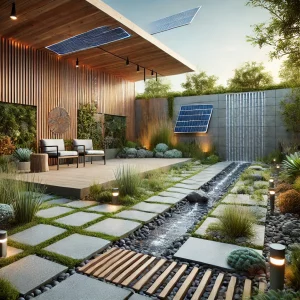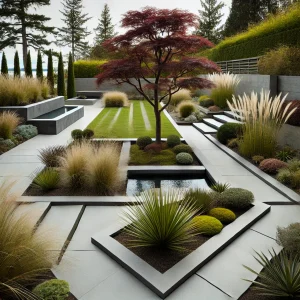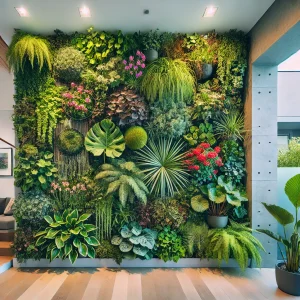As we approach 2025, garden aesthetics are evolving rapidly, especially in British Columbia, where nature meets urban life in unique and dynamic ways. Garden design trends are shifting, blending functionality with artistic elements to create outdoor spaces that are both beautiful and practical. Sustainability and technology are driving these changes, making the gardens of tomorrow greener, smarter, and more visually striking. Let’s explore the top trends that will dominate garden aesthetics in 2025, particularly in the stunning landscapes of British Columbia.

1. Sustainability Meets Style: Natural Materials and Eco-Friendly Practices
One of the strongest trends for 2025 focuses on the increased use of sustainable materials in garden design. British Columbia’s natural beauty inspires gardeners and landscapers to incorporate materials that not only look good but also have minimal environmental impact. Natural elements like reclaimed wood, locally sourced stone, and recycled materials are becoming key design components.
For example, using permeable pavers made from recycled materials helps reduce runoff during British Columbia’s frequent rains. These pavers allow water to filter into the ground, supporting the region’s natural ecosystem while maintaining a sleek, modern look.
In addition, gardeners integrate rainwater harvesting systems to reduce water waste. Systems like RainMachine, a smart irrigation controller, use weather data to optimize water usage. This is especially important in regions like BC that experience both heavy rains and dry spells. These solutions conserve resources and ensure that gardens maintain a lush, healthy appearance year-round.

2. Minimalism and Modern Design
Minimalist design continues to gain popularity as homeowners and designers opt for clean lines and uncluttered spaces. In British Columbia, where natural beauty is abundant, gardens increasingly serve as extensions of the surrounding landscape rather than separate, ornamental features.
Minimalist gardens often feature geometric layouts with strategically placed plants, water features, and seating areas. Focusing on a few key elements—such as a carefully pruned Japanese maple tree or a sleek, polished stone pathway—creates a serene, modern aesthetic.
Plant choices reflect this minimalist approach, with low-maintenance species like ornamental grasses, succulents, and native plants taking center stage. Native plants, especially practical for BC gardens, adapt well to the region’s unique climate, requiring less water and care.

3. Smart Technology and Garden Automation
As technology advances, garden aesthetics are seeing more smart solutions integrated into everyday maintenance. In British Columbia, where weather can be unpredictable, smart garden systems provide convenience and are essential for maintaining a beautiful landscape with minimal effort.
Products like the RainMachine Smart Wi-Fi Sprinkler Controller allow homeowners to automate irrigation based on real-time weather conditions. This technology helps ensure gardens remain healthy during dry summers while preventing over-watering during the rainy season. Smart systems merge function with design, discreetly installed and managed remotely, giving homeowners control without sacrificing the garden’s visual appeal.
Another exciting trend is the rise of solar-powered garden lighting. Not only does this reduce energy consumption, but it also highlights pathways, garden beds, and water features, enhancing the space’s overall aesthetics. These lights come in sleek, modern designs that complement minimalist and eco-friendly garden styles.

4. Creative Plant Arrangements: Where Art Meets Functionality
The 2025 garden trends are redefining plant arrangements by combining creativity with functionality. Vertical gardens and living walls, already popular in urban environments, are becoming staples in British Columbia homes. These arrangements maximize limited space while contributing to the home’s insulation, improving air quality, and even producing edible plants like herbs and strawberries.
British Columbia’s climate is particularly conducive to vertical gardening, with many opting to use modular systems that can be customized to grow native plants or hardy species like ferns, hostas, and climbing ivy. These vertical gardens are visually striking and serve practical purposes, such as providing privacy or acting as natural sound barriers in urban areas.
Another innovative concept is the creation of pollinator-friendly gardens, which attract bees, butterflies, and other beneficial insects. With its rich biodiversity, British Columbia is perfect for cultivating gardens that support the local ecosystem. Plants like lavender, echinacea, and salvia not only add vibrant colors and textures but also play a crucial role in promoting biodiversity and sustainability.

5. Adapting to Climate: Designing for Resilience
British Columbia’s diverse climate—from the rainy coasts to the dry interior—presents unique challenges for gardeners. One trend emerging for 2025 focuses on climate-resilient garden designs.
In coastal areas, where heavy rainfall and cooler temperatures are common, designers use raised garden beds and bioswales to manage water flow and prevent erosion. In the drier interior regions of BC, drought-resistant plants like sedums, lavenders, and yuccas are becoming more popular, as water conservation becomes key. These resilient plants bring texture and color to garden designs, creating visually appealing yet practical spaces.
The future of garden aesthetics in 2025 revolves around finding harmony between beauty and function. In British Columbia, a region known for its natural splendor, this trend is especially significant. From sustainable materials and minimalist designs to smart technology and climate-resilient plants, the gardens of tomorrow will be as innovative as they are breathtaking. Whether you’re a homeowner creating an eco-friendly sanctuary or a landscaper merging art with functionality, the trends of 2025 ensure your garden will be both a visual masterpiece and a sustainable, practical space.